- 03 JUIN
- FRANCE – 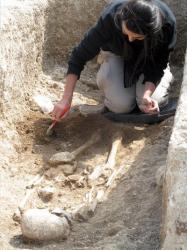
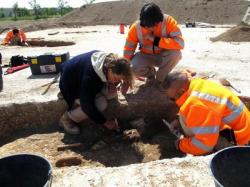 Tours sur Marne - Des vestiges ont été retrouvés, au cœur d'un lotissement, là même où un éco-quartier devait voir le jour. Six tombes ont été déterrées et une autre sur un second site non loin du premier. Sur les deux sites de Tours-sur-Marne, cinq personnes ont donc enfilé le bleu de chauffe il y a près de trois semaines : quatre archéologues et une anthropologue. L'équipe creuse méticuleusement les espaces où se trouvent les tombes. À la truelle, à l'aide d'un pinceau ou encore avec les mains afin de ne prendre aucun risque de détérioration. Les premières découvertes affleurent : des fragments d'os et de métaux dans une tombe et près de l'intégralité d'un squelette dans une autre. « Il faut réussir à établir des connexions entre les différents morceaux d'os, explique un membre de l'équipe d'archéologues. Il se pourrait que le métal provienne des restes d'une épée. » Le temps, l'humidité, la terre produisent leurs effets et il est souvent impossible de retrouver l'intégralité d'un corps, d'un objet ou même d'un vêtement. quelle époque datent les trouvailles ? « Ce que nous avons déterré provient de l'époque antique de - 250 -150 avant Jésus-Christ. Un siècle avant l'arrivée des Romains en Gaule du Nord », souffle Yoann Rabasté, archéologue en chef du chantier.
Tours sur Marne - Des vestiges ont été retrouvés, au cœur d'un lotissement, là même où un éco-quartier devait voir le jour. Six tombes ont été déterrées et une autre sur un second site non loin du premier. Sur les deux sites de Tours-sur-Marne, cinq personnes ont donc enfilé le bleu de chauffe il y a près de trois semaines : quatre archéologues et une anthropologue. L'équipe creuse méticuleusement les espaces où se trouvent les tombes. À la truelle, à l'aide d'un pinceau ou encore avec les mains afin de ne prendre aucun risque de détérioration. Les premières découvertes affleurent : des fragments d'os et de métaux dans une tombe et près de l'intégralité d'un squelette dans une autre. « Il faut réussir à établir des connexions entre les différents morceaux d'os, explique un membre de l'équipe d'archéologues. Il se pourrait que le métal provienne des restes d'une épée. » Le temps, l'humidité, la terre produisent leurs effets et il est souvent impossible de retrouver l'intégralité d'un corps, d'un objet ou même d'un vêtement. quelle époque datent les trouvailles ? « Ce que nous avons déterré provient de l'époque antique de - 250 -150 avant Jésus-Christ. Un siècle avant l'arrivée des Romains en Gaule du Nord », souffle Yoann Rabasté, archéologue en chef du chantier.
http://www.lunion.presse.fr/article/culture-et-loisirs/des-vestiges-gaulois-a-tours-sur-marne
USA – 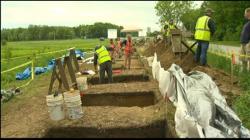
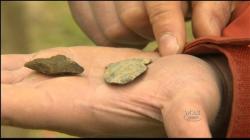 South Burlington - Vermont Air National Guard. Archaeologists are carefully sifting through the earth to learn more about Vermont's history. This land in South Burlington is known to be the site of a 700 to one thousand year-old Native American settlement which was discovered a few years ago in advance of the road construction. The Air Guard also called in the University of Vermont's Consulting Archaeology Program's John Crock to study the site. "One of the questions we are trying to answer is how large this settlement is, where are certain activity areas -- house areas vs. refuse areas. But it is a pretty extensive site that looks to be occupied about 700 years ago," Crock said. So far the team has found a lot of triangular projectile points, also known as arrow heads and spear tips. "This side notch is called the Otter Creek type, after a number of sites at the Otter Creek near Vergennes, Vermont," Crock said. "This one dates back nearly 4-thousand years ago." Other finds include what was once flooring, and a food storage pit outlined in the earth. All of the artifacts and other information that is unearthed will be carefully cleaned, categorized and perhaps one day put on display. There are two other sites on this property that will not be disturbed. The road has been re-engineered around them to preserve them for future digs.
South Burlington - Vermont Air National Guard. Archaeologists are carefully sifting through the earth to learn more about Vermont's history. This land in South Burlington is known to be the site of a 700 to one thousand year-old Native American settlement which was discovered a few years ago in advance of the road construction. The Air Guard also called in the University of Vermont's Consulting Archaeology Program's John Crock to study the site. "One of the questions we are trying to answer is how large this settlement is, where are certain activity areas -- house areas vs. refuse areas. But it is a pretty extensive site that looks to be occupied about 700 years ago," Crock said. So far the team has found a lot of triangular projectile points, also known as arrow heads and spear tips. "This side notch is called the Otter Creek type, after a number of sites at the Otter Creek near Vergennes, Vermont," Crock said. "This one dates back nearly 4-thousand years ago." Other finds include what was once flooring, and a food storage pit outlined in the earth. All of the artifacts and other information that is unearthed will be carefully cleaned, categorized and perhaps one day put on display. There are two other sites on this property that will not be disturbed. The road has been re-engineered around them to preserve them for future digs.
http://www.wcax.com/story/14828888/air-base-project-provides-archaeological-opportunity
- ROYAUME-UNI – Norton - Archaeologists have finished excavating remains of a medieval village in Runcorn. A team from Oxford Archaeology North had stumbled on a 13th century street near Highgate Close in Norton Village while preparing it for a building project. Among the 80 items found were shards of medieval pottery, a post medieval bronze lion head and 20th century dog skeletons. Jamie Quartermaine, senior project manager, said the lion head is from the 16th or 17th century and was probably worn as a hat badge. He said discovery of timber frame post holes was ‘highly significant’ because it means medieval builders had preplanned the village as a street, which was ‘extremely rare’. The historic items have been sent to Norton Priory for storage and display. Mr Quartermaine said hopes of finding bronze age remains did not come to fruition but that charcoal pieces have been sent for carbon dating. Result will be returned in four weeks. He added that archaeological discoveries usually happen where there is heavy development. He said finds in the North West are rare because of a combination of a lack of interesting sites and heavy farming before the industrial revolution.
http://www.runcornandwidnesweeklynews.co.uk/runcorn-widnes-news/runcorn-widnes-local-news/2011/06/02/pottery-dog-skeletons-and-lion-head-badge-discovered-in-medieval-excavation-in-norton-runcorn-55368-28802390/
- ROYAUME-UNI – 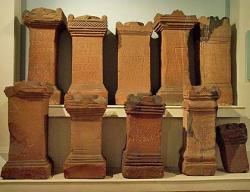 Maryport - A major archaeological investigation into the mystery of a group of Roman stones found more than 140 years ago has begun on the Hadrian’s Wall World Heritage Site in Cumbria. The Roman altars, dedicated to the Roman God of Jupiter, were found by local digger Humphrey Senhouse at Camp Farm in 1870, buried under farmland enclosing the Maryport fort and civilian settlement. Commanders made one stone annually for 17 years as commemorations to their careers across the empire, but their exact purpose remains unknown. “The Maryport altars have been at the centre of international debate about the nature of religion in the Roman army for decades now,” says Newcastle University’s Professor Ian Haynes, a specialist in the archaeology of the Roman Empire who is renowned for leading excavations on religious sites. “We still know very little about the context in which they were originally deposited. Excavation is the only way to advance the debate.”
Maryport - A major archaeological investigation into the mystery of a group of Roman stones found more than 140 years ago has begun on the Hadrian’s Wall World Heritage Site in Cumbria. The Roman altars, dedicated to the Roman God of Jupiter, were found by local digger Humphrey Senhouse at Camp Farm in 1870, buried under farmland enclosing the Maryport fort and civilian settlement. Commanders made one stone annually for 17 years as commemorations to their careers across the empire, but their exact purpose remains unknown. “The Maryport altars have been at the centre of international debate about the nature of religion in the Roman army for decades now,” says Newcastle University’s Professor Ian Haynes, a specialist in the archaeology of the Roman Empire who is renowned for leading excavations on religious sites. “We still know very little about the context in which they were originally deposited. Excavation is the only way to advance the debate.”
http://www.culture24.org.uk/history+%26+heritage/archaeology/art357318
- USA – 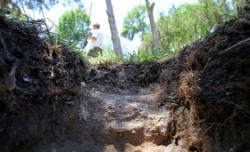 St Augustine - At the Nombre de Dios mission site near downtown St. Augustine it's been a hold-onto-your-hats kind of week following the discovery of a Spanish mission church older than the Castillo de San Marcos. The Spanish began building the Castillo in 1672, but didn't complete it until 1695. The church was built in 1677. In the test holes, workers are finding artifacts that match those stored in the boxes at the Florida Museum. Some of the coquina foundations are gone. On Thursday morning the latest prize was a piece of painted plaster that featured a light colored square surrounded by red. "It's lost some of the red already," said worker Peter Larson of the item that had been out of the ground about an hour. That bit probably came from one of the murals on the wall, Deagan said. "This is a truly exciting rediscovery of a long-lost building. Nombre de Dios mission was the first and longest lasting of the Spanish Franciscan missions in Florida, and the Shrine of La Leche was famous in its time for its fine workmanship and decoration," Deagan said. Future excavations will help determine when the building was first constructed and if it is built on top of even earlier ruins. ABOUT THE NEW DISCOVERY : The church, ordered by the Spanish governor of Florida, was constructed in 1677. Its size is at least 90 feet by 40 feet. It consists of coquina stone and tabby foundations. It is the only mission church made of stone. It is one of largest churches in colonial Spanish Florida. Research at the site and a dig at the Foun-tain of Youth are supported by the Florida Museum of Natural History and the Lastinger Family Foundationw. ABOUT THE SITE : Shrine of Mission of Nombre de Dios/Nuestra Senora de la Leche. Owned by the Catholic Diocese of St. Augustine. Nombre de Dios Mission, first Franciscan mission in Florida. Mission established 1587, lasted until 1760. In the 1620s, Shrine of Nuestra Senora de La Leche and Buen Parto (Our Lady of the Milk and Safe Delivery) were established at site . Why is this find special? Although the Spanish began construction of the Castillo de San Marcos in 1672, it wasn't completed until 1695. The rediscovered church was built in 1677. Twice the British took over the church and battles were fought on the site. In 1728 after English raiders destroyed the building, the Spanish blew it up to keep it from being used again as a staging ground. Through the years the ruins gradually became buried and the location forgotten. Stone from the building was probably used to construct another church on the property and when that church was taken down, archaeologists speculate it was used for construction of the church that eventually became the Cathedral Basilica of St. Augustine.
St Augustine - At the Nombre de Dios mission site near downtown St. Augustine it's been a hold-onto-your-hats kind of week following the discovery of a Spanish mission church older than the Castillo de San Marcos. The Spanish began building the Castillo in 1672, but didn't complete it until 1695. The church was built in 1677. In the test holes, workers are finding artifacts that match those stored in the boxes at the Florida Museum. Some of the coquina foundations are gone. On Thursday morning the latest prize was a piece of painted plaster that featured a light colored square surrounded by red. "It's lost some of the red already," said worker Peter Larson of the item that had been out of the ground about an hour. That bit probably came from one of the murals on the wall, Deagan said. "This is a truly exciting rediscovery of a long-lost building. Nombre de Dios mission was the first and longest lasting of the Spanish Franciscan missions in Florida, and the Shrine of La Leche was famous in its time for its fine workmanship and decoration," Deagan said. Future excavations will help determine when the building was first constructed and if it is built on top of even earlier ruins. ABOUT THE NEW DISCOVERY : The church, ordered by the Spanish governor of Florida, was constructed in 1677. Its size is at least 90 feet by 40 feet. It consists of coquina stone and tabby foundations. It is the only mission church made of stone. It is one of largest churches in colonial Spanish Florida. Research at the site and a dig at the Foun-tain of Youth are supported by the Florida Museum of Natural History and the Lastinger Family Foundationw. ABOUT THE SITE : Shrine of Mission of Nombre de Dios/Nuestra Senora de la Leche. Owned by the Catholic Diocese of St. Augustine. Nombre de Dios Mission, first Franciscan mission in Florida. Mission established 1587, lasted until 1760. In the 1620s, Shrine of Nuestra Senora de La Leche and Buen Parto (Our Lady of the Milk and Safe Delivery) were established at site . Why is this find special? Although the Spanish began construction of the Castillo de San Marcos in 1672, it wasn't completed until 1695. The rediscovered church was built in 1677. Twice the British took over the church and battles were fought on the site. In 1728 after English raiders destroyed the building, the Spanish blew it up to keep it from being used again as a staging ground. Through the years the ruins gradually became buried and the location forgotten. Stone from the building was probably used to construct another church on the property and when that church was taken down, archaeologists speculate it was used for construction of the church that eventually became the Cathedral Basilica of St. Augustine.
http://staugustine.com/news/local-news/2011-06-02/long-lost-church-found
- USA –  Ash Grove - Shards of ceramic and old toys are developing a picture of life in this rural community more than 100 years ago -- and some of the images are fascinating. An archaeological dig by Missouri State students around an old homestead on the Berry property in Ash Grove is under way this summer and will likely continue next year. Results of the dig will be compared to digs on the nearby Nathan Boone Homestead, completed last year. Nathan Boone was the son of famed frontiersman Daniel Boone. For archaeologists and historians, the work done on the Boone and Berry homesteads provides a look into a unique social setting. Sobel said most research on race relations in the 19th and early 20th centuries has focused on large urban areas and the deep South.
Ash Grove - Shards of ceramic and old toys are developing a picture of life in this rural community more than 100 years ago -- and some of the images are fascinating. An archaeological dig by Missouri State students around an old homestead on the Berry property in Ash Grove is under way this summer and will likely continue next year. Results of the dig will be compared to digs on the nearby Nathan Boone Homestead, completed last year. Nathan Boone was the son of famed frontiersman Daniel Boone. For archaeologists and historians, the work done on the Boone and Berry homesteads provides a look into a unique social setting. Sobel said most research on race relations in the 19th and early 20th centuries has focused on large urban areas and the deep South.
http://www.news-leader.com/article/20110603/NEWS01/106030326/1007/Students-unearth-racial-past-Ash-Grove-dig
- INDE – Vindhyachal - A grocery shop owner, with a hobby of exploring archaeological treasures, has claimed to have discovered a rock painting site dating back over 10,000 years on the hilltop of Vindhyachal hill terrain in Rajasthan's Bhilwara district. Over 1,000 images drawn in sharp ochre, dark red and brown colours were discovered on June 1 on the banks of Chambal river in six shelters in 'Gendi Ka Chajja' area, said amateur archaeologist Om Prakash Sharma 'Kukki', who had earlier also discovered a rock painting stretching up to 35km of pre-historic age in Garadha area of Bundi district. The images include human figures with long and slim physical constitution and long hair and figures of wild animals. Kukki, who has been awarded by the government for his contribution to discovering rock painting sites in Rajasthan, has so far discovered over 79 sites of rock paintings in the state. He said that the new rock painting site is unique as it is situated on the hill top where about 15-20 foot high rock shelters are erected. Most of the rock paintings sites in the world are generally found in the lower shelters on the river banks.
http://www.dnaindia.com/india/report_stone-age-rock-painting-site-discovered-in-rajasthan_1550727